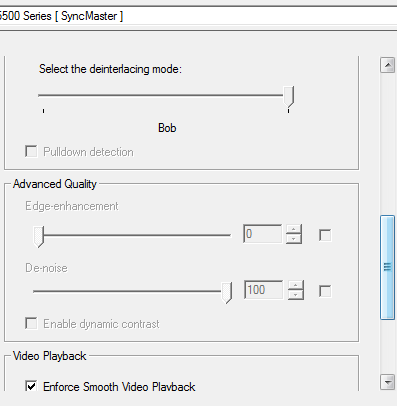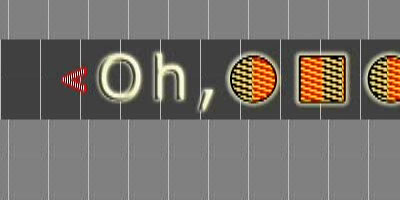AMD’s Radeon HD 5570: Low Profile, Higher Performance
by Ryan Smith on February 9, 2010 12:00 AM EST- Posted in
- GPUs
Still Not the Perfect HTPC Card
After encountering the video decoding limitations of the 5450 in our review of that card, we had been expecting the 5570 to finally fill the role of the perfect HTPC card. Since we had already seen that the 5670 had full video acceleration capabilities under any circumstance, it wouldn’t be much of a stretch for the 5570 to deliver a repeat performance.
Unfortunately that hasn’t come to pass, in fact if anything its proven the 5450 isn’t quite as good of an HTPC card as we first thought.
But before we get ahead of ourselves, let’s start with what’s been a wrench in our plans the entire time: the Enforce Smooth Video Playback option in AMD’s drivers. ESVP is an option in AMD’s drivers that does exactly what it says on the box: it ensures that any videos playing through AMD’s UVD2 decoder play back smoothly. After talking to AMD we’ve come to understand that this is a quality of service mechanism, with there apparently being a couple of different factors involved. The biggest factor as far as the video card is concerned is that when ESVP is enabled, it allows the drives to disable any post-processing features they believe might impact the playback performance of the card.

The AVIVO control panel on the Radeon HD 5570
We’re still going back and forth with AMD trying to get the full details on how ESVP works, but from what we understand thus far and what we’re seeing in the Catalyst Control Center, it looks like AMD is hardcoding their drivers to disable certain post-processing features when ESVP is enabled, depending on the hardware being used. In the case of the 5570, virtually all post-processing features are disabled when ESVP is enabled, with the only remaining options being to select between Bob and Weave deinterlacing.
This actually made us reexamine our 5450, since it didn’t disable so many features when ESVP is enabled. As it turns out that’s a bug in the current version of the drivers for the 5450, and in spite of what the Catalyst Control Center is showing, the 5450 cannot use any additional post-processing features beyond what the 5570 can use, meaning that Edge Enhancement and De-Noise don’t actually work on the 5450 when ESVP is enabled.
As a result, the 5570 does no better on the Cheese Slices video test than the 5450. With ESVP enabled, it can’t do Vector Adaptive Deinterlacing to correct jagged lines on things such as sports fields. It’s still a small issue, but it stands in the way of HTPC perfection.

Cheese Slices:
Radeon 5670 Deinterlacing

Cheese Slices:
Radeon 5570 Deinterlacing
Ultimately the 5450 and 5570 are both limited-functionality cards for HTPC use, giving users the choice between video playback QoS and post-processing. In our testing we didn’t notice any obvious playback issues with the 5450 or 5570 when we had ESVP disabled, but we’ve seen enough forum posts of this feature magically fixing poor video playback performance that we’re not confident enough to recommend disabling this feature. It’s something we think should be left enabled, at least for the time being.
This makes the 5670 the most-perfect HTPC card, as we’ve found it to be able to offer all of AMD’s post-processing features with ESVP enabled, and of course it offers audio bitstreaming like the rest of the 5000 series. The downside to this is that the 5670 is $99, it isn’t low-profile, and at 70W TDP it’s not a particularly cool card. It’s certainly more than workable as an HTPC card, but until someone can get a 5670 out there that’s passively cooled, it’s not the ideal HTPC card that enthusiasts have been looking for.
We’ll also quickly add to this that this all depends on AMD’s drivers, rather than the hardware. Certainly AMD can tweak things if they determine that the 5570 has enough power to do more post-processing, but obviously there’s no guarantee that will happen.










36 Comments
View All Comments
andy o - Tuesday, February 9, 2010 - link
I think you mean "when ESVP is enabled" here:"it looks like AMD is hardcoding their drivers to disable certain post-processing features when ESVP is disabled"
andy o - Tuesday, February 9, 2010 - link
Ryan, I don't think this is such a big deal:"In our testing we didn’t notice any obvious playback issues with the 5450 or 5570 when we had ESVP disabled, but we’ve seen enough forum posts of this feature magically fixing poor video playback performance that we’re not confident enough to recommend disabling this feature. It’s something we think should be left enabled, at least for the time being."
I don't think there's any "magically fixing" for those people was probably done because of ESVP disabling post-processing features and nothing esoteric, so I think it's safe to assume that this aggressive disabling of feature by ESVP on these drivers is a bug, and you can safely disable it, and just enable some post-processing options you want, as long as you don't get choppy video or have issues with A/V sync.
I don't see how ESVP could affect smooth video playback more than what was explained by AMD (seems the forum user I mentioned on the 5450 thread was right about what it does). Once you have all the video frames showing in sync (no dropped frames), there's nothing more to make the video smoother besides using more post-processing to interpolate video and show it at higher refresh rates (which is clearly not happening here, and it would require a 120 Hz monitor at least.
juhatus - Tuesday, February 9, 2010 - link
Remember that AA absolutly kills this card? So whats the point showing it on the big table-results.How would it compare to other sub-100 cards without AA?
knowom - Tuesday, February 9, 2010 - link
Most cards bottleneck more with AA turned on and people tend to prefer having AA turned on as opposed to off when possible.juhatus - Tuesday, February 9, 2010 - link
3870 uses its shaders to do the AA, hence the bad AA results.16ROPS 256bit memory and ~400shaders shouln't compare too badly to this card without AA.
OCedHrt - Tuesday, February 9, 2010 - link
Per your numbers, the 5670 is 15W, not 25W, more under load.jigglywiggly - Tuesday, February 9, 2010 - link
This card is fail.Pino - Tuesday, February 9, 2010 - link
It´s perfect for me.I just play Day of Defeat Source and TF2, and I have a Dell Vostro 200 a low profile chassis, with a limited 200W PSU.
knowom - Tuesday, February 9, 2010 - link
Pretty much the GT 240 basically wipes the floor with it in terms of performance, power, and noise. I don't see any real selling points on this card even DX11 and Eyefinity don't seem too viable on such a castrated card performance wise.Get the GT240 instead or spend the extra $10-$20's on a better performance card or save yourself a $10-$15's on the quieter and more energy efficient one is what it boils down to.
mczak - Tuesday, February 9, 2010 - link
I think that's a bit harsh, though really the review was harsh I think in fact it was a bit unfair.- the lower power draw of the gt240 has no connection to reality. All other reviews (some of them measuring power draw directly, some at the wall) show the hd5570 has a quite a bit lower power draw than the gt240 ddr3 under load (at idle it's a wash), not to mention the gt240 gddr5 (or HD4670) which are even a bit higher. I strongly suspect either something was wrong with the sample card or measurement error (or rather, not keeping the setup consistent).
- the RE5 numbers are very puzzling, and I'd say they are just bogus. Toms also tested this game, and the HD5570 just behaved like in any other title (that is, close to HD4670) there. Seems a lot more believable.
- the comparison to gt240 gddr5 seems a tad unfair. Now AMD thinks this should be compared to gt220 which isn't really useful, but it seems to me that price-wise it will be really the same as the gt240 ddr3, not gddr5 version. Granted, that's probably only a 10 dollar difference but when talking about 80$ cards this does make a difference.